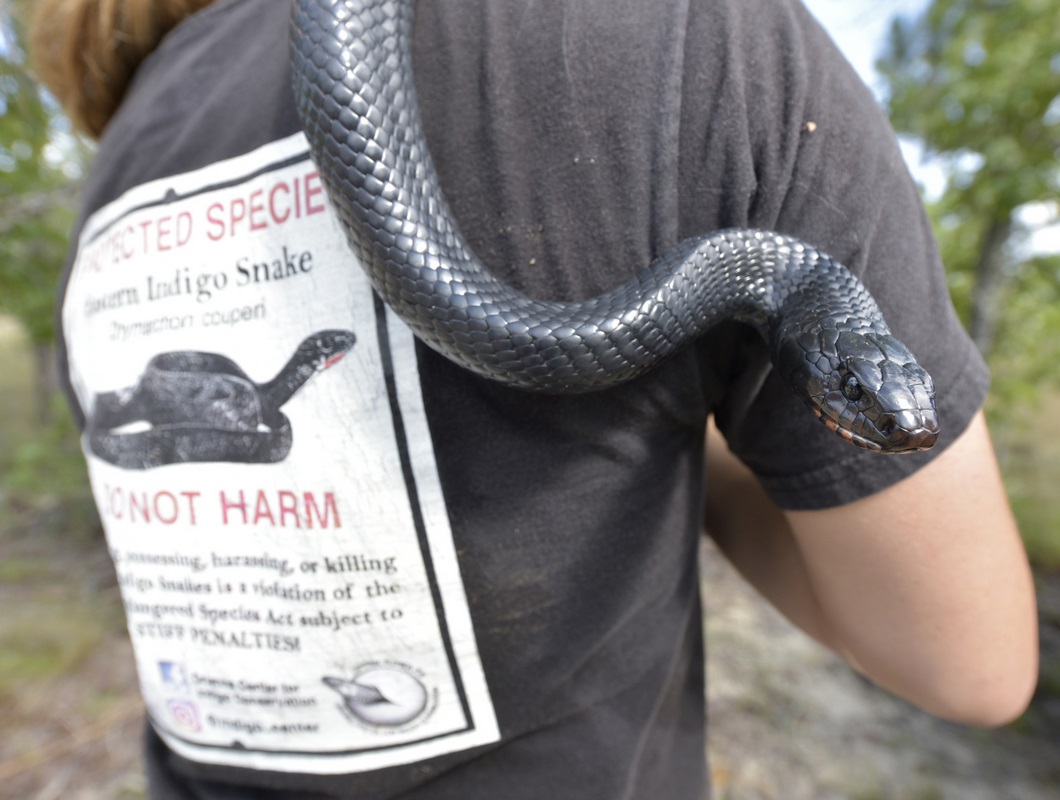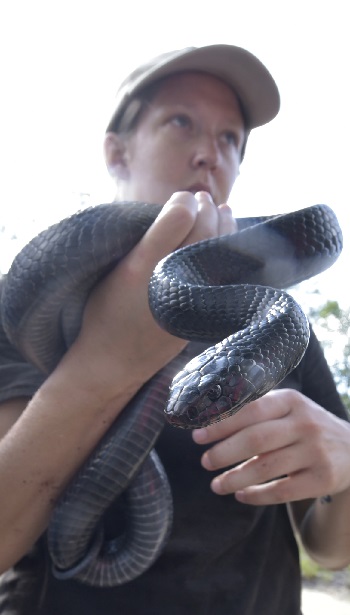 Twenty federally threatened eastern indigo snakes have just been released in northern Florida at The Nature Conservancy’s Apalachicola Bluffs and Ravines Preserve (ABRP)as part of a collaborative endeavor to return the native, nonvenomous apex predator to the region. The release of the snakes marks the second year in a row of the reintroduction effort, and furthers the long-term joint plan of multiple nonprofit, agency, and academia partners to restore this important species to the region.
Twenty federally threatened eastern indigo snakes have just been released in northern Florida at The Nature Conservancy’s Apalachicola Bluffs and Ravines Preserve (ABRP)as part of a collaborative endeavor to return the native, nonvenomous apex predator to the region. The release of the snakes marks the second year in a row of the reintroduction effort, and furthers the long-term joint plan of multiple nonprofit, agency, and academia partners to restore this important species to the region.
The Nature Conservancy, Central Florida Zoo’s Orianne Center for Indigo Conservation, Auburn University, the Florida Fish and Wildlife Conservation Commission (FWC), U.S. Fish and Wildlife Service, The Orianne Society, Joseph W. Jones Ecological Research Center, Gulf Power, Southern Company through the National Fish and Wildlife Foundation, and the Fish & Wildlife Foundation of Florida are dedicated to supporting the recovery of this species. The eastern indigo snake is the longest snake native to North America and an iconic and essential component of the now rare southern longleaf pine forest. The partners have worked together for decades to restore and manage the habitat required by the snake, and many other species, to make the release possible.
The eastern indigo serves a critical function to balance the wildlife community – it consumes a variety of small animals including both venomous and nonvenomous snakes. At over 8 feet long, this impressive snake often relies upon gopher tortoise burrows for shelter. The snakes were historically found throughout southern Georgia, Alabama, eastern Mississippi, and throughout Florida, though their range is now far more restricted. 
Largely eliminated from northern Florida due to habitat loss and fragmentation, the indigo was last observed at ABRP in 1982, until 2017 when 12 snakes were released to the preserve. This year’s annual release is part of a 10-year commitment to the species’ recovery and continues a focus on establishment of healthy ecosystems through collaborative land, water and wildlife conservation efforts.
“We continue our dedication to creating a healthy, balanced, and restored longleaf pine ecosystem at the Conservancy’s Apalachicola Bluffs and Ravines Preserve and throughout the region, to encourage the recovery of the eastern indigo snake and support many other important plants and wildlife,” said Temperince Morgan, Executive Director of The Nature Conservancy in Florida. “This second annual release results from the teamwork of an incredible group of partners.”
ABRP is the only site in Florida currently designated for indigo reintroduction. The 6,295-acre nature preserve in northern Florida’s Liberty County protects a large longleaf pine landscape carved by numerous seepage streams. Located in the Apalachicola Bay region along the Apalachicola River, the preserve lies in the center of one of five biological hotspots in North America. This treasure trove of species diversity is unique to Florida and home to a disproportionate number of imperiled species. The preserve is a living laboratory for the development of novel restoration techniques and land management excellence, dedicated to natural community restoration, preservation of biodiversity, and education and training.
The longleaf pine ecosystem is one of the most diverse ecosystems globally, yet only 5 percent of this precious landscape remains. Over the past 30 years, The Nature Conservancy has employed science and technical expertise to develop the state-of-the-art groundcover restoration process that is now used by state, federal and private partners across the southeast to restore longleaf pine habitat. This restoration, combined with the Conservancy’s robust prescribed fire program, has resulted in improved longleaf habitat on over 100,000 public and private north Florida acres in recent years.
Longleaf pine restoration is also a top priority at places like the Apalachicola National Forest and Torreya State Park – both neighbors to ABRP and supported by the U.S. Forest Service and Florida Department of Environmental Protection.
Bred and raised by the Orianne Center for Indigo Conservation, the world’s foremost comprehensive-based conservation organization dedicated to reptiles and amphibians, the 20 young snakes – 12 males and eight females – have most recently been living in outdoor enclosures that allowed them to be exposed to a more natural environment in preparation for their release. The snakes have been implanted with radio transmitters by the Central Florida Zoo‘s vet staff to allow for tracking and monitoring. Data is still being transmitted and collected from the snakes that were released last year to help inform recovery efforts.
“The Central Florida Zoo’s Orianne Center for Indigo Conservation is proud to aid in the recovery of the eastern indigo snake in Florida,” said Michelle Hoffman, Deputy Director of the Orianne Center for Indigo Conservation. “This second annual release of 20 animals puts us one step closer to achieving our goal of reestablishing this species in the Florida Panhandle.”
The Orianne Society was integral in the creation of the indigo snake reintroduction team and continues to play a role in reintroducing eastern indigo snakes into places they no longer occur. The Society works to conserve critical ecosystems for imperiled reptiles and amphibians, using science, applied conservation, and education.
Auburn University’s Alabama Natural Heritage Program continues to bring knowledge to planning reintroduction efforts and expertise in onsite monitoring of the reintroduced snakes. Using radio telemetry, researchers can track the animals’ movements, habitat selection and behavior. One of the eastern indigo snakes that was released in 2017 traveled over a mile from where it was initially released. The monitoring program is supported in part by The Joseph W. Jones Ecological Research Center, whose mission is to understand, demonstrate and promote excellence in natural resource management and landscape conservation in the southeastern coastal plains.
The indigo reintroduction efforts are supported by grants and other funding, including a Conserve Wildlife Tag Grant from the Fish & Wildlife Foundation of Florida, funded through purchase of Conserve Wildlife Florida license plates and designated for conservation of non-game species and the habitats that support them.
“The release of 20 eastern indigo snakes is another step forward toward our goal of reestablishing this iconic imperiled species back into the habitats of northwest Florida,” said Kipp Frohlich, the FWC’s Director of Habitat and Species Conservation. “It’s a testament to what can be accomplished working together with many committed conservation partners.
Additional funding to support the reintroduction has been provided by Gulf Power, and Southern Company through the National Fish and Wildlife Foundation.
“All of the pieces have come together – the protection and management of the landscape, the advancement of the animal husbandry expertise to raise young snakes for release, and the development of the science necessary to make good decisions and monitor project success. This project is an exceptional example of a strong partnership dedicated to success,” said David Printiss, North Florida Program Manager of The Nature Conservancy in Florida. “The restoration is complete, the snakes are flourishing, and the monitoring program is well equipped and ready – all systems are go!”
Throughout the state, the Conservancy continues to pursue conservation projects and support policy that protects natural systems for people and wildlife. Next year’s snake release will be scheduled for summer 2019 – stay tuned.
